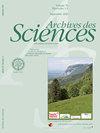Effect of the photoperiod on the plasma membrane ATP-dependent H + -pumping activity of spinach petioles
Q3 Multidisciplinary
引用次数: 2
Abstract
Effect of the photoperiod on the plasma membrane ATP-dependent H+-pumping activity of spinach petioles. The plasma membrane from spinach (Spmac/a o/eracea, cv.Nobel) petioles was purified by phase partitioning and the use of enzyme markers showed that this fraction was highly enriched in plasma membrane vesicles. This fraction was almost devoid of phosphohydrolase activities originating from endomembranes (tonoplastes, mitochondria, non specific phosphatases and golgi apparatus). The ATP-dependent H+ pumping activity in this fraction was Mg^+ and K+ dependent and was not stimulated by valinomycin. It was unsensitive to nitrate (tonoplaste ATPase inhibitor) but sensitive to vanadate (plasma membrane ATPase inhibitor). This activity was specific for ATP and had a pH optimum around 6.5. The kinetic constants (Km.,pp and for ATP) of the H+ pumping activity of the purified plasma membrane were determined from plants grown in short days (vegetatives) and from similar plants induced by 24 h of continuous light. Whereas Km have not been changed after light induction, values of and the activity in the presence of 0.5 mB ATP have been increased suggesting a regulation of the enzyme after light induction. Key-words: H+-ATPase, Plasma membrane, Sp/rtac/a o/eracea. Abbreviations: ADP. Adenosine diphosphate; ATP, Adenosine triphosphate; BSA, bovine serum albumin; BTP, bis-tris-propane (1.3-bis (tris (hydroxymtehyl) methylamino) propane); DTT, dithiothreitol; GTP. Guanosine triphosphate; 1DP, inosine diphosphate; Mes. 4-morpholinoethane sulfonic acid; PNPP, p-nitrophenylphosphate; PMSF, phenylmethylsulfonylfluoride: PPj, Pyrophosphate; Tris, Tris (hydroxy methyll-aminomethane; UDPG, uridine diphosphoglucose.光周期对菠菜叶柄质膜atp依赖性H +泵送活性的影响
光周期对菠菜叶柄质膜atp依赖性H+泵送活性的影响。用相分配法纯化了菠菜(Spmac/a / o/eracea, cv.Nobel)叶柄的质膜,酶标记表明该部分在质膜囊泡中高度富集。这个部分几乎没有来自细胞膜(线粒体、非特异性磷酸酶和高尔基体)的磷酸水解酶活性。atp依赖性H+泵送活性依赖于Mg^+和K+,不受缬霉素的刺激。对硝酸根(肌膜atp酶抑制剂)不敏感,对钒酸盐(质膜atp酶抑制剂)敏感。该活性对ATP具有特异性,pH值在6.5左右为最佳。动能常数(Km)在短日照植物(植物)和24 H连续光照诱导的类似植物上测定纯化质膜H+泵送活性的变化。虽然光诱导后Km没有改变,但在0.5 mB ATP存在下,其值和活性增加,表明光诱导后酶的调节。关键词:H+- atp酶,质膜,Sp/rtac/a / o/eracea缩写:ADP。二磷酸腺苷;三磷酸腺苷;牛血清白蛋白;BTP,双-三-丙烷(1.3-双(三(羟基)甲基胺)丙烷);德勤、二硫苏糖醇;三磷酸鸟苷。三磷酸鸟苷;1DP,二磷酸肌苷;Mes. 4-morpholinoethane磺酸;PNPP p-nitrophenylphosphate;PMSF,苯基甲基磺酰氟;PPj,焦磷酸盐;Tris, Tris(羟基甲基氨基甲烷;UDPG,尿苷二磷酸葡萄糖。
本文章由计算机程序翻译,如有差异,请以英文原文为准。
求助全文
约1分钟内获得全文
求助全文
来源期刊

Archives Des Sciences
综合性期刊-综合性期刊
CiteScore
1.10
自引率
0.00%
发文量
0
审稿时长
1 months
期刊介绍:
Archives des Sciences est un journal scientifique multidisciplinaire et international. Les articles sont soumis à un comité
de lecture.
 求助内容:
求助内容: 应助结果提醒方式:
应助结果提醒方式:


